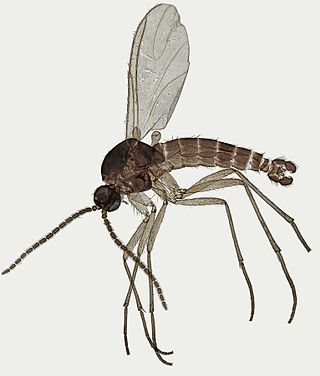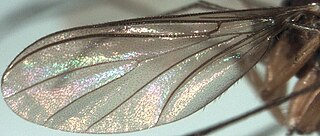
The Nematocera are a suborder of elongated flies with thin, segmented antennae and mostly aquatic larvae. This group is paraphyletic and contains all flies but species from suborder Brachycera, which includes more commonly known species such as the housefly or the common fruit fly. The equivalent clade to Nematocera is the whole Diptera, with Brachycera as a subclade. Families in Nematocera include mosquitoes, crane flies, gnats, black flies, and multiple families commonly known as midges. The Nematocera typically have fairly long, fine, finely-jointed antennae. In many species, such as most mosquitoes, the female antennae are more or less threadlike, but the males have spectacularly plumose antennae.

The Nematoceran family Axymyiidae is the sole member of the infraorder Axymyiomorpha, though it is often included within the infraorder Bibionomorpha in older classifications. It is known from only nine species in four genera, plus eight fossil species.

The Sciaridae are a family of flies, commonly known as dark-winged fungus gnats. Commonly found in moist environments, they are known to be a pest of mushroom farms and are commonly found in household plant pots. This is one of the least studied of the large Diptera families, probably due to the small size of these insects and the similarity among species.

Sciaroidea is a superfamily in the infraorder Bibionomorpha. There are about 16 families and more than 15,000 described species in Sciaroidea. Most of its constituent families are various gnats.

Herina is a genus of flies in the family Ulidiidae. It is possibly the largest genus in the family.

Corynoptera is a genus of fungus gnats in the family Sciaridae.
Opesia grandis is a European and Asian species of fly in the family Tachinidae.

Clinocerinae is a subfamily of flies belonging to the family Empididae.

Empidinae, also called dance flies, are a subfamily of empidoid flies. They are mainly predatory flies like most of their relatives, and generally small to medium-sized. Most species are flower visitors and they can be effective pollinators.
Bradysia austera is a species of fungus gnat found in the British Isles.
Bradysia ismayi is a species of fungus gnat found in the British Isles.
Bradysia nigrispina is a species of fungus gnat found in the British Isles.
Corynoptera uncata is a species of fungus gnat found in the British Isles.
Epidapus subgracilis is a species of fungus gnats found in the British Isles.

Bradysia ocellaris is a species of fly in the family Sciaridae. It is found in the Palearctic. It has also been introduced to Australia. It feeds on fungi, and larvae can feed on cultivated plants in greenhouses.

Lygistorrhininae, commonly called long-beaked fungus gnats is a subfamily of flies in the Diptera family Keroplatidae. The groups was long treated as a separate family, but molecular phylogenetic analysis has shown it to belong to Keroplatidae. There are about 7 genera and at least 30 described species in Lygistorrhininae.
Pnyxia is a genus of dark-winged fungus gnats, insects in the family Sciaridae. There are at least four described species in Pnyxia.

Rangomaramidae is a family of flies in the infraorder Bibionomorpha. The family, members of which are known as long-winged fungus gnats, was erected in 2002 by Jaschhof and Didham to include five new species of flies in the genus Rangomarama from New Zealand. The family was then expanded to include several other genera from across the world which were formerly classified as Sciaroidea incertae sedis, but preliminary studies show that the broad family is non-monophyletic.










